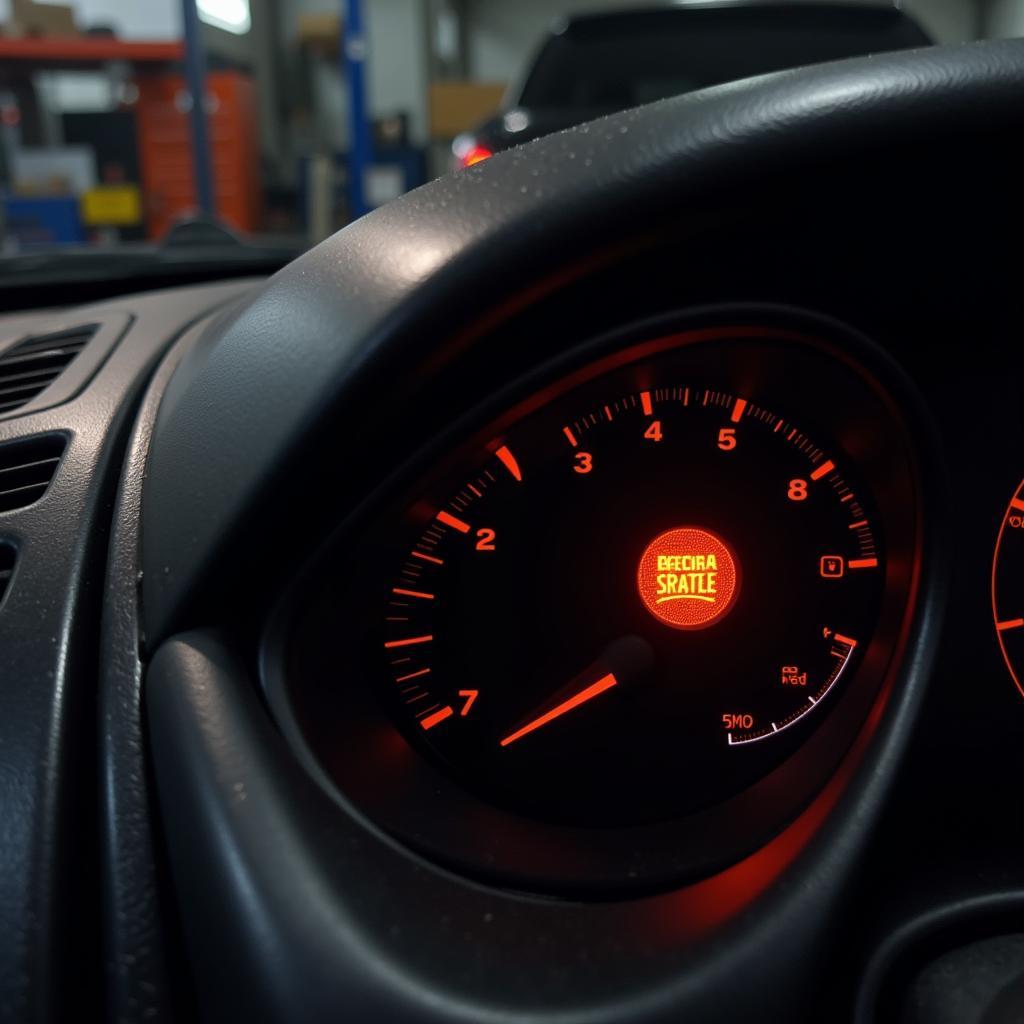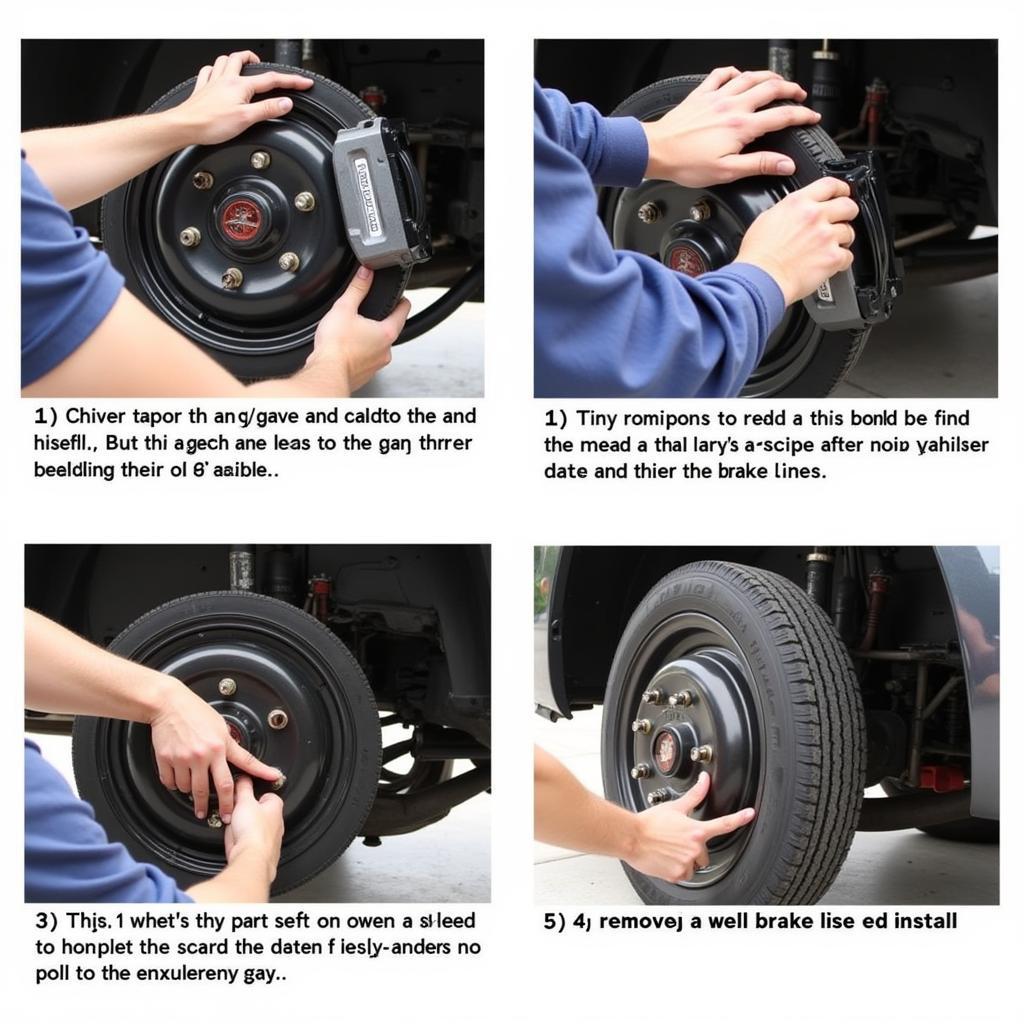A stuck brake caliper can be a frustrating and potentially dangerous issue, often announcing its presence with a persistent brake warning light on your dashboard. This comprehensive guide delves into the intricacies of stuck calipers, exploring the causes, symptoms, and solutions to get you back on the road safely.
 Car with a stuck caliper and brake warning light illuminated
Car with a stuck caliper and brake warning light illuminated
What Does a Stuck Caliper Mean?
Your car’s braking system relies on a harmonious interplay of components, with brake calipers playing a pivotal role. These hydraulic marvels clamp the brake pads onto the rotors when you hit the brake pedal, generating the friction needed to slow down or stop your vehicle.
A stuck caliper, as the name suggests, disrupts this delicate dance. It occurs when the caliper’s piston, responsible for pushing the brake pads, gets stuck in its housing, preventing the caliper from releasing properly. This constant engagement of the brake pads with the rotor leads to a cascade of problems, including excessive heat, premature wear, and compromised braking performance.
Common Causes of a Stuck Caliper
Several culprits can lead to a stuck caliper, ranging from wear and tear to corrosion and fluid leaks:
- Corrosion: Over time, exposure to moisture, road salt, and debris can lead to corrosion on the caliper piston and its surrounding components, hindering smooth movement and causing it to stick.
- Torn Piston Boot: The piston boot, a protective rubber seal around the caliper piston, prevents contaminants from entering the caliper. A torn boot can allow dirt and grime to infiltrate the system, leading to corrosion and sticking.
- Brake Fluid Issues: Old, contaminated, or moisture-laden brake fluid can wreak havoc on your brake system, including causing corrosion and sticking within the caliper.
- Slide Pin Problems: Calipers use slide pins coated in grease to ensure smooth movement along the caliper bracket. Worn or seized slide pins due to lack of lubrication can hinder caliper operation, mimicking the symptoms of a stuck piston.
Recognizing the Warning Signs
Ignoring the telltale signs of a stuck caliper can lead to costly repairs and safety hazards. Be vigilant and watch out for these common symptoms:
- Illuminated Brake Warning Light: The most apparent sign, a glowing brake warning light on your dashboard, often indicates a problem within the braking system, including a potential caliper issue.
- Burning Smell While Driving: A persistent, acrid odor emanating from your brakes while driving signals excessive heat buildup, often due to a caliper that’s constantly engaging the rotor.
- Vehicle Pulling to One Side: A stuck caliper can create uneven braking force, causing your car to pull to one side when you apply the brakes, potentially leading to dangerous handling issues.
- Reduced Fuel Economy: The constant friction generated by a stuck caliper forces your engine to work harder, leading to a noticeable dip in fuel efficiency.
- Unusual Brake Pedal Feel: A stuck caliper can manifest as a spongy, stiff, or low brake pedal, indicating a disruption in the normal hydraulic pressure within the braking system.
If you experience any of these symptoms, it’s crucial to address the issue promptly. Continuing to drive with a stuck caliper not only compromises your safety but can also lead to more extensive and expensive damage to your braking system.
Diagnosing a Stuck Caliper
Pinpointing the exact culprit behind your brake woes requires a systematic approach:
- Visual Inspection: Begin by safely jacking up your car and securing it on jack stands. Examine the brake calipers for visible signs of corrosion, leaks, or damage, paying close attention to the piston boot’s condition.
- Check for Uneven Rotor Wear: Inspect the brake rotors for uneven wear patterns. A rotor with excessive wear on one side compared to the other suggests a potential caliper issue on the side with more wear.
- Feel for Excessive Heat: After a drive, cautiously touch the wheel rims. A noticeably hotter rim on one side compared to the others indicates a caliper that’s not releasing properly and generating excessive heat.
- Assess Caliper Movement: Try to compress the caliper piston using a C-clamp or a large pair of pliers. Difficulty compressing the piston or a piston that doesn’t retract smoothly points towards a stuck caliper.
Remember, safety is paramount when working on your vehicle. If you’re uncomfortable with any of these steps or lack the necessary tools and experience, it’s always best to consult a qualified mechanic for a thorough diagnosis.
Solutions for a Stuck Caliper
Addressing a stuck caliper often involves one of two primary approaches:
- Caliper Lubrication and Repair: For less severe cases involving seized slide pins or minor corrosion, lubricating the caliper slide pins and cleaning the caliper components might suffice. This involves disassembling the caliper, cleaning and greasing the slide pins, and ensuring the piston moves freely. However, this solution is often temporary, and a more permanent fix might be necessary.
- Caliper Replacement: In cases of severe corrosion, a torn piston boot, or internal damage to the caliper, replacement is often the most viable option. While it might seem daunting, replacing a brake caliper is a manageable task for those with basic mechanical skills, especially with the plethora of online resources and video tutorials available.
 Replacing a car brake caliper
Replacing a car brake caliper
Seeking Professional Help: When and Why?
While a do-it-yourself approach can be tempting and cost-effective, certain situations warrant the expertise of a qualified mechanic:
- Lack of Experience: If you’re not comfortable working on your car’s braking system, it’s best to leave it to the professionals.
- Severe Damage: Extensive corrosion, internal caliper damage, or other complex issues often necessitate specialized tools and knowledge best handled by a trained mechanic.
- Safety Concerns: Your car’s braking system is critical for your safety and that of others on the road. If you’re unsure about any aspect of the repair, err on the side of caution and consult a professional.
Preventing Future Caliper Issues
Prevention is always better than cure, and a few simple maintenance practices can go a long way in preventing future stuck caliper woes:
- Regular Brake Fluid Flushes: Adhere to your car manufacturer’s recommended brake fluid flush intervals. Fresh brake fluid helps prevent corrosion and ensures optimal braking system performance.
- Inspect Your Brakes Regularly: Make it a habit to visually inspect your brakes during routine maintenance or oil changes. Look for signs of leaks, corrosion, or wear and tear, addressing any issues promptly.
- Address Brake Problems Immediately: Ignoring brake problems, even seemingly minor ones, can exacerbate the issue and lead to more costly repairs down the line. Don’t delay seeking professional help when needed.
Remember, a well-maintained braking system is paramount for your safety and the longevity of your vehicle. By staying proactive and addressing potential issues promptly, you can enjoy countless miles of worry-free driving.
FAQs about Stuck Calipers
Can I drive with a stuck caliper?
It’s highly discouraged to drive with a stuck caliper. It compromises your braking performance, reduces fuel efficiency, and can lead to more extensive damage to your braking system.
How much does it cost to fix a stuck caliper?
The cost of fixing a stuck caliper varies depending on the severity of the issue, the make and model of your car, and labor rates. A simple caliper lubrication might cost a few hundred dollars, while a complete caliper replacement can range from a few hundred to over a thousand dollars.
Can a stuck caliper cause the brake pedal to go to the floor?
While a stuck caliper usually results in a stiff or low brake pedal, it can potentially lead to the pedal going to the floor if the problem is left unaddressed and causes significant brake fluid loss or internal damage to the caliper.
Can I replace just one caliper, or do I need to replace both?
While replacing only the affected caliper is possible, mechanics often recommend replacing both calipers on the same axle to ensure even braking performance and prevent future issues.
How long can you drive with a sticking caliper?
You should address a sticking caliper issue immediately. Continuing to drive with a sticking caliper can lead to further damage and safety hazards.
Remember, these FAQs are for informational purposes only. Always consult a qualified mechanic for personalized advice and repairs related to your vehicle.

